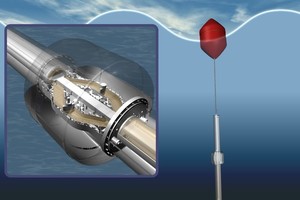
Ocean waves are an enormous available resource of clean, renewable energy. They have an energy density 10 times higher than wind and 100 times higher than solar energy. The flux of ocean wave energy is also more stable and predictable than wind, for example, making it easier to optimize power outtake and forecast power production.

Also, the potential for wave energy production is enormous. There are several locations around the globe that are suitable for wave power generation and it could potentially cover 10-20% of worldwide electricity consumption. The unique features of ocean wave energy make it a very strong alternative for the generation of 100% clean, renewable energy with no carbon dioxide emissions.
- Vast available resource can cover 10-20% of worldwide energy consumption
- Clean and renewable energy no carbon dioxide emissions
- Predictable output power levels can be forecast 1-2 days in advance
- Timing - different from wind and solar, beneficial for grid balancing
- Seasonal load - correlates with electricity consumption (northern hemisphere)
- Power density - 10x wind and 100x solar
The Wave Energy Converters (WEC) developed by CorPower Ocean are small and light with low inertia creating the advantage of being energized by a broad range of waves as well as enabling easy mass production and lowering capital expenditure costs. They are also fault tolerant and importantly deliver a predictable electricity output with a distributed electricity generation concept. In terms of energy output CorPower’s technology offers exceptionally high power density, 5 times higher than competing technologies at less than a third of the cost.
The compact WEC systems are of the point absorber type, with a buoy on the ocean surface absorbing energy from waves. The WEC is located at a depth between the surface and sea bottom where it is protected from rough seas. Force is transferred to the WEC by a buoy tether, and it is moored to the sea bed. Flexible connection points automatically minimize harmful lateral forces on the WEC. Our WEC has a unique Power Take-Off (PTO) design that combines the high load capabilities from hydraulics with the efficiency of a direct mechanical drive. Temporary energy storage is provided by a two-step approach, smoothing the electrical power output compared to the power profile of typical ocean waves and minimizing the cost of electronic components. The system has been designed for low inertia and high structural efficiency, allowing the use of active phase control to optimize power absorption.

Man könnte sagen, es schlagen zwei Herzen in Stig Lundbäcks Brust. Eins für die Medizin, denn Lundbäck erforschte früher als Arzt die Strömungsverhältnisse im menschlichen Herz. Das brachte ihn zu seiner zweiten Leidenschaft: Energie aus dem Meer. Ende der 80er-Jahre erkannte Lundbäck, dass der Herzmuskel in den Herzkammern wie eine Kolbenpumpe arbeitet. Entleeren sich die Kammern in die Arterien, baut sich ein Unterdruck auf, der die Klappen zwischen Haupt- und Vorkammern öffnet und das Blut einsaugt.
Dieses Prinzip übertrug er auf einen Wellenenergiekonverter in Form einer Meeresboje: Ein Prototyp schaukelt seit einem Jahr erfolgreich in einem Wellenkanal in Stockholm. Er besitzt in seinem Inneren einen Kolben, der mit einer Kette am Beckenboden verankert ist. Der Kolben erzeugt in einem Zylinder einen Unterdruck, wenn eine Welle anzusteigen und die Boje mitzunehmen beginnt. Kurz bevor die Welle ihren höchsten Stand erreicht, wird der Unterdruck entlastet. Dadurch schießt die Boje nach oben und tänzelt auf dem Wasser auf und ab. Diese Bewegung setzt Zahnräder in einem Getriebe in Gang, das den Effekt weiter verstärkt und einen Generator antreibt.
Mit seiner Idee gründete Lundbäck vor fünf Jahren das Start-up CorPower. Wie die Boje mit den Wellen des winterlich-rauen Atlantiks klarkommt, sollen Anfang 2015 Versuche mit einem 8x18 Meter großen Prototyp vor der portugiesischen Küste zeigen. Anders als viele bisherige Methoden nutzt Lundbäcks nicht nur das Auf und Ab der Wellen, sondern auch einen Großteil ihrer potenziellen Energie, wie sie auch eine gespannte Feder "speichert". Die Boje soll fünfmal mehr Energie aus einer Wellenfront herausholen als bisherige Wellenkraftwerke. Eine 300-Kilowatt-Boje könnte im Jahr 900000 Kilowattstunden Strom produzieren, genug für 250 Haushalte, sagt Patrick Möller, Chef von CorPower. Durch den geringen Materialeinsatz und die niedrigen Investitions- und Wartungskosten soll der Strom mit maximal 15 Eurocent pro Kilowattstunde nicht teurer sein als der von Windkraftanlagen.
